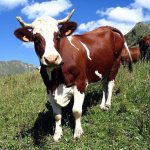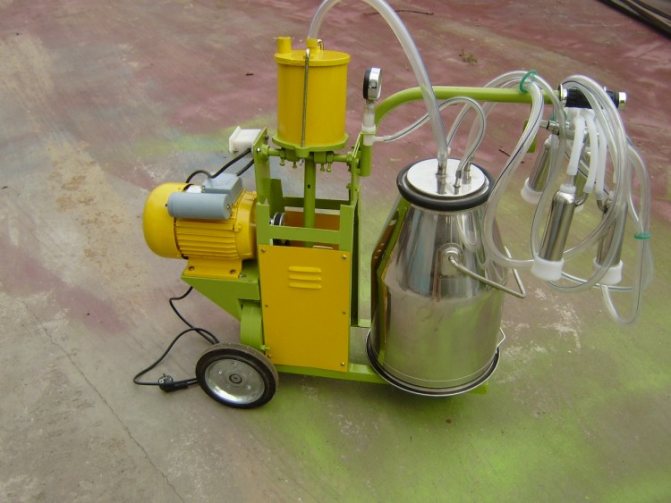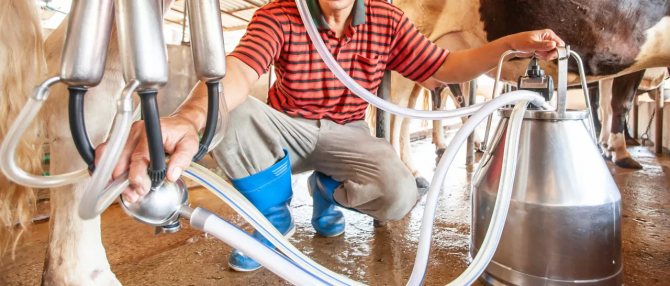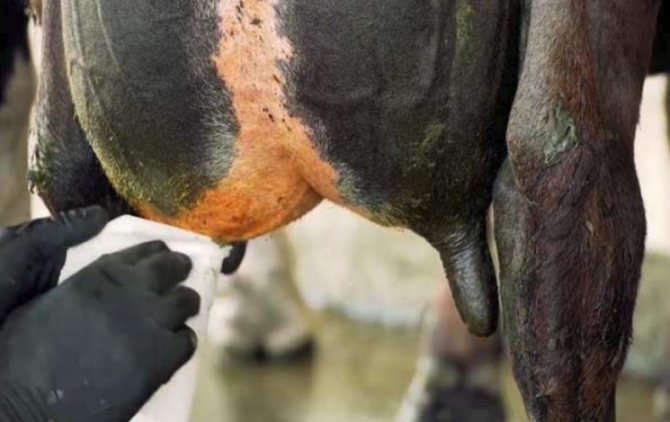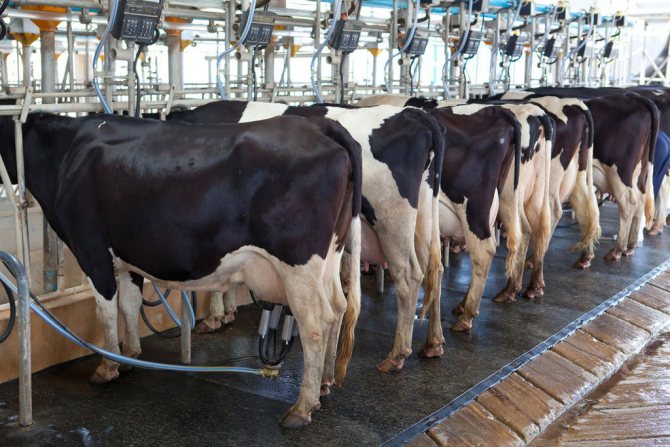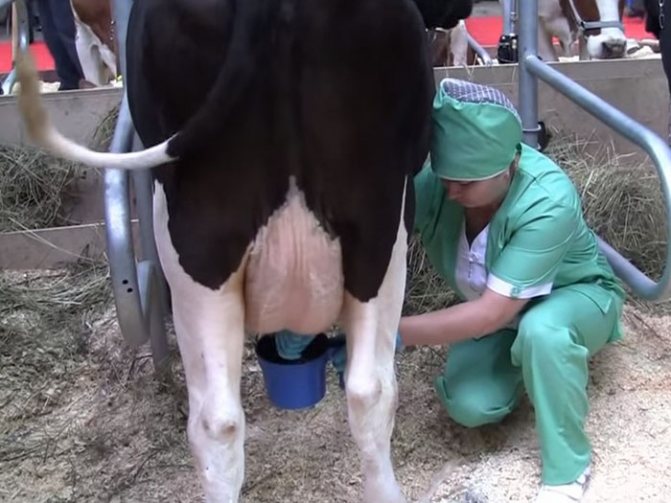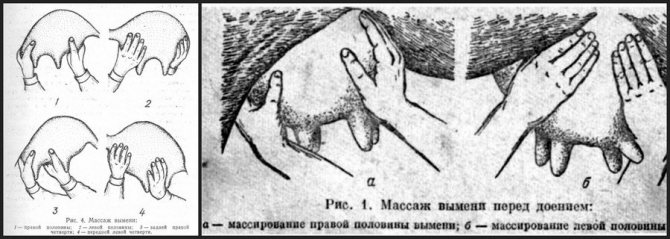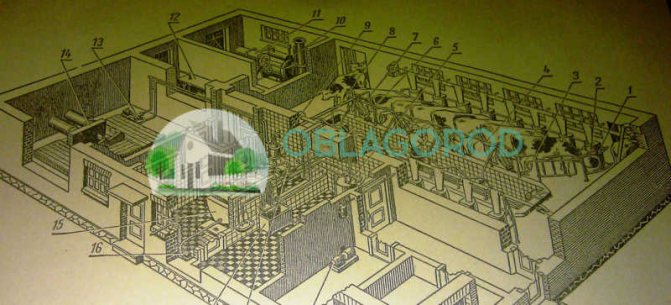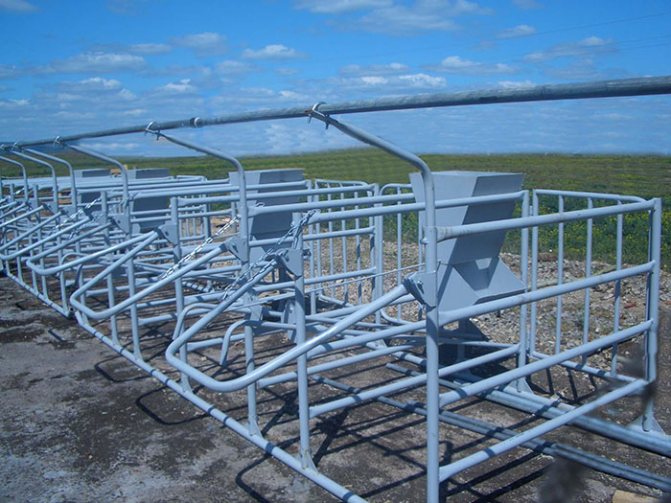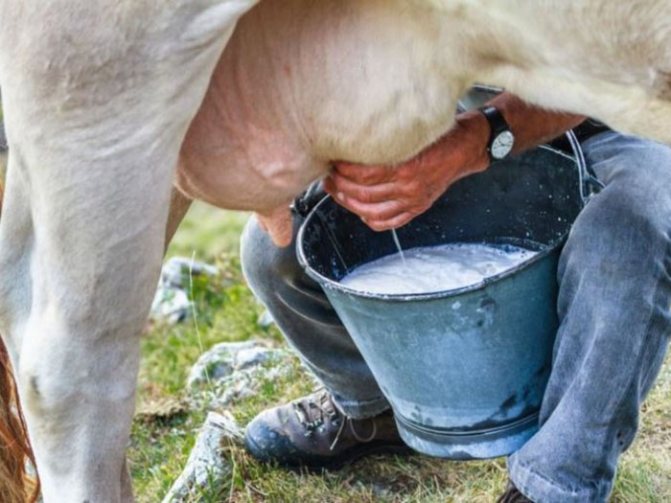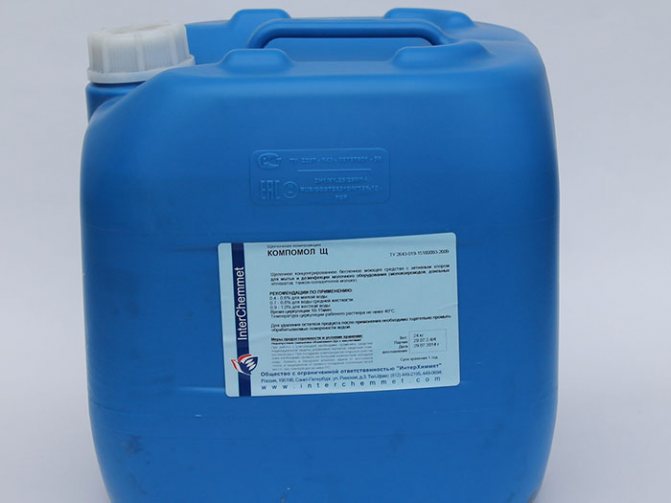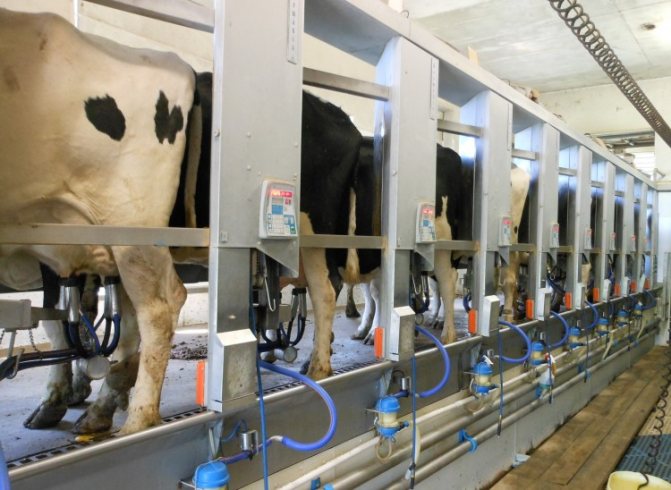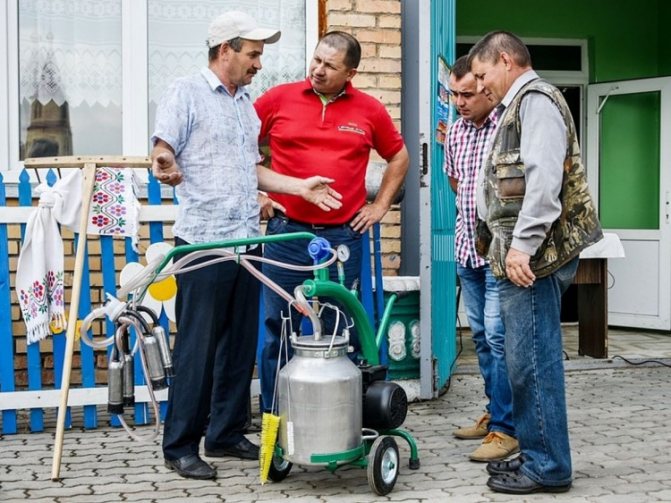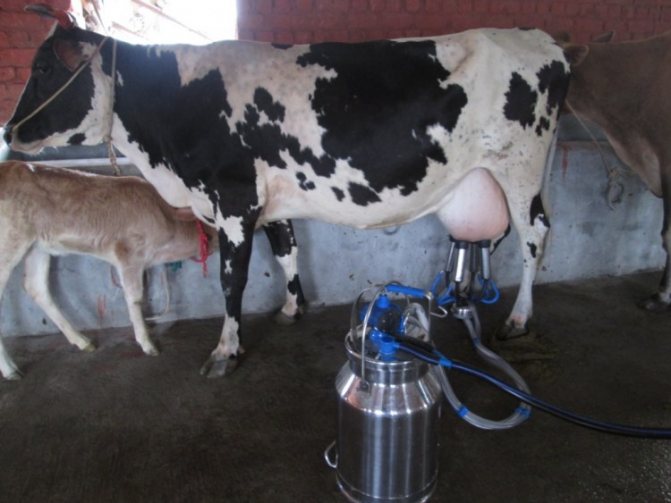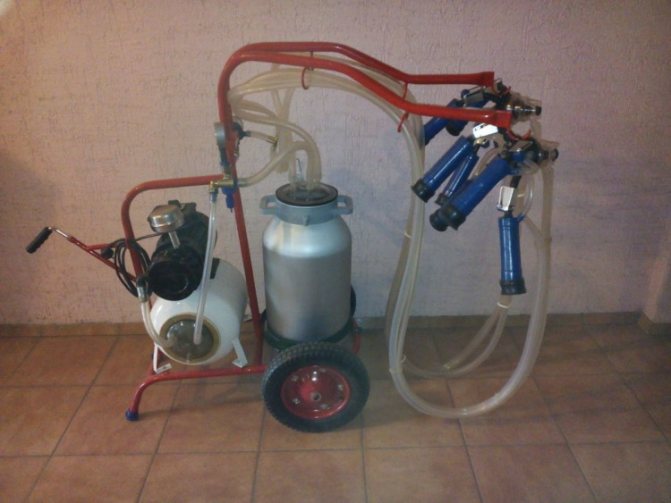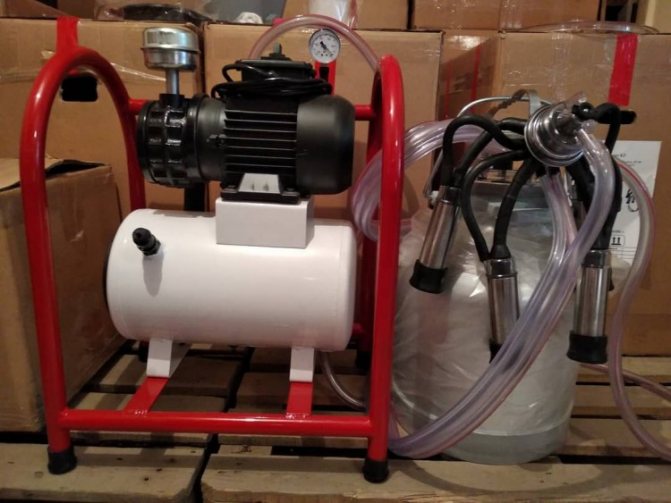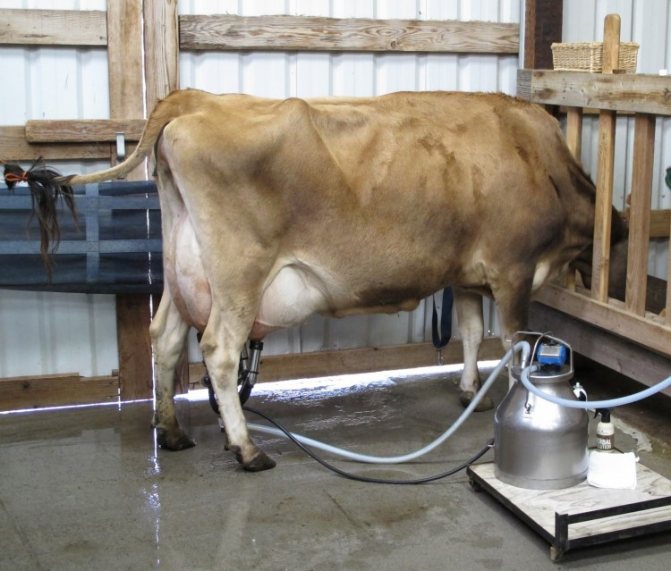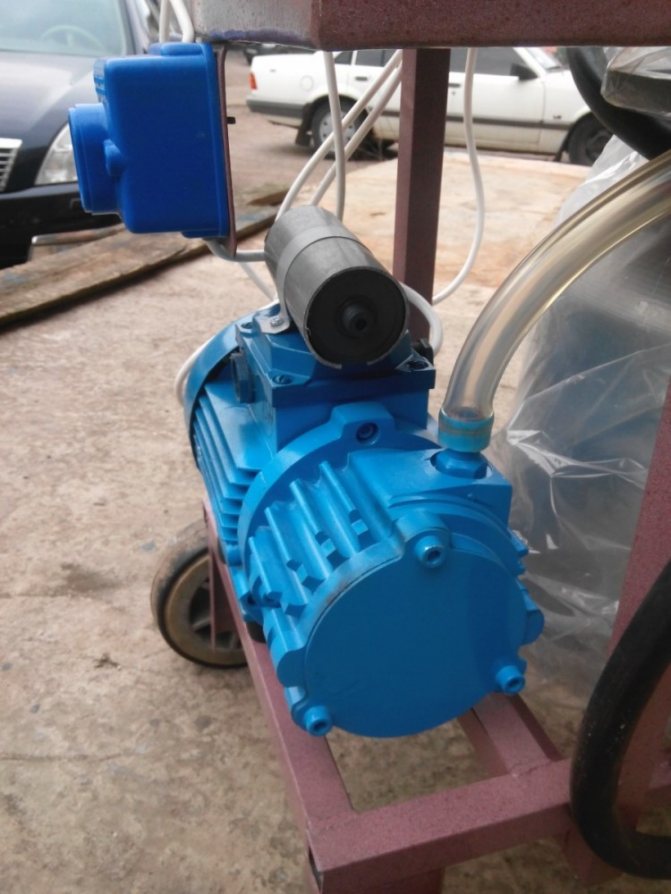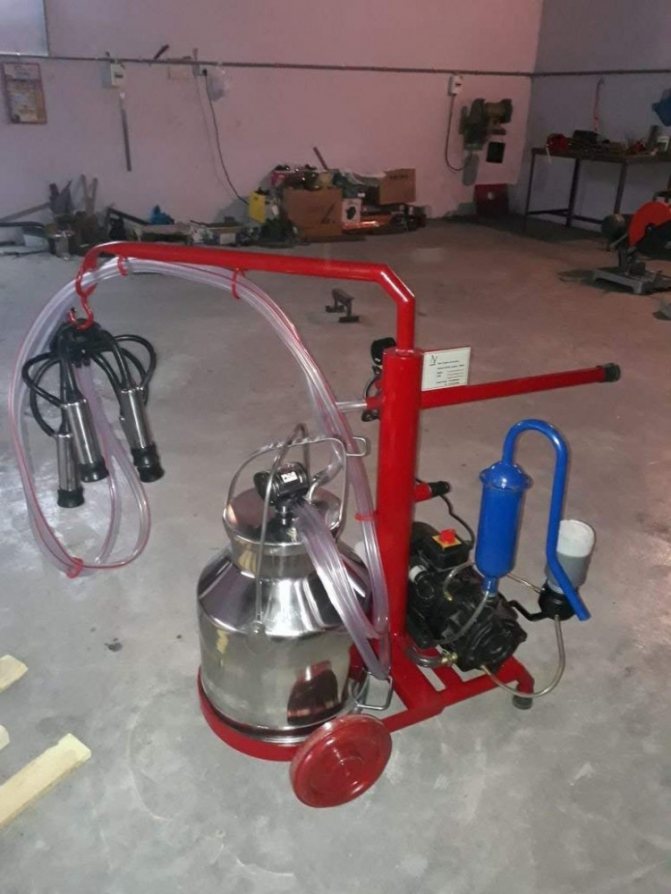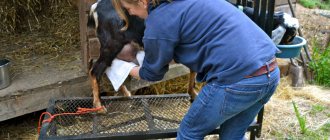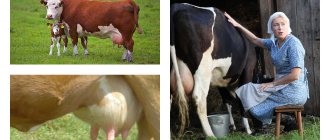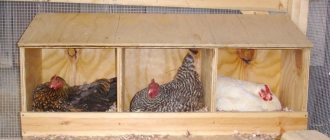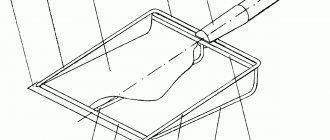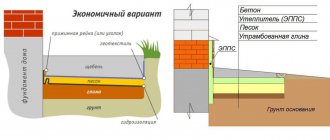The volume of cow's milk depends on many factors. Among them are the quantity and quality of feed, the season, the health of the cattle, including emotional ones, and much more. Often, inexperienced milkmaids, with their inept actions, can harm the cow, which negatively affects milk yield. Therefore, before starting an animal or starting the procedure for milking cows at home, you should familiarize yourself with the basic rules and study the technique.
How many times should a cow be milked
Particular attention should be paid to the udder. It is thoroughly washed with warm water and wiped dry with a soft towel. Hands should be washed and warmed before milking, since when milking with cold hands, the female will not give milk.
Figure 1. Massage technique
In order for the cow to give milk faster, a certain algorithm of actions should be followed:
- It is better to sit on the right side, although this is an optional condition.
- Before each milking, massage is done, stroking the right and left halves, first along the length and then along the width. Then you need to push all the lobes of the udder, as a sucking calf does. The nipples are simply squeezed slightly without trying to squeeze out the milk. If the individual is too sensitive, simply rubbing is sufficient. A detailed massage scheme is shown in Figure 1.
- You need to milk quickly, with your hand clenched into a fist. This method is better than milking with two fingers (with a pinch), since the latter often injures the tissues of the nipple.
The amount of milk produced by a cow depends on the number of milkings, since it is full and frequent milking that stimulates milk production (in nature, lactation in animals, as the offspring grows up, gradually decreases and fades away).
How many times a particular animal should be milked depends on its condition and age. Milking is carried out at least 2 times a day (the maximum interval is 12 hours, since milk secretion is inhibited after filling the udder after 12-14 hours).
The optimal mode for the herd is three milking at intervals of 12 hours at night and 6 during the day. Milking cows at intervals of less than 3 hours is not recommended (except for the first few days after calving, when the cow is milked every 2-3 hours).
So that the milk yield does not decrease and the animals do not have health problems, the cows need to be milked at the same time while maintaining the same interval between approaches.
When milking twice, when drawing up a milking schedule, the productive characteristics of the breed are taken into account - with an average level of productivity for a herd, an interval of 12 hours is optimal, and with high productivity and a well-developed udder of animals, the interval can be uneven (11 and 13 hours, the time for sleep increases).
It should be borne in mind that three times milking increases milk productivity by 5-15%, depending on the productivity of the herd.
The milking schedule of a cow before calving changes - 7 days before starting (stopping milking) the number of milkings is reduced to one time (milking in the morning and in the evening alternate), and then a dry period is observed for 40-60 days. If a cow is highly productive or is pregnant for the first time, the dry period increases to 70-77 days.
In order not to frighten off the cow, it is necessary to approach it only from the front.The animal reacts positively to the voice of a familiar person, listens attentively to his intonation. To relieve the tension that has arisen, the cow can be stroked, treated with a delicacy, and talked to her.
It is customary to milk the cow on the right side, but this is not necessary. The main thing is that it is always one side. The milkmaid chair should be stable and comfortable. Compliance with all the rules stimulates the return of milk.
The average amount of milk a cow has is about 70 liters per day. The frequency of milking depends on the breed, age, health status.
The first months after calving, the cow is milked up to 5-6 times a day. Later, they switch to the optimal milking three times a day. Milking is carried out twice before starting. Regardless of the number of milkings, it is necessary to observe the milking hours for full milk flow. In cows accustomed to the regimen, the content of dairy products before milking increases.
Before milking a cow, you need to establish contact with her. Best of all, if a woman comes up to the animal, pet it, call it by name. Burenki quickly get used to the owners, recognize them, and it often happens that some people are given more milk than others.
You also need to keep in mind the issue of hygiene. Before milking, you need to take care of cleanliness by wiping the udder and legs of the animal with a clean cloth. You also need to wash your hands thoroughly. It is advisable to wash them in warm water, as during hand milking, the cow may not milk well if the hands are cold. The tail of a cow is usually tied to the leg.
Milking must be done in a clean stall. Manure needs to be removed, and dry straw should be laid under the feet. If the weather permits, you can ventilate the barn and leave the door open.
In order to get the most milk, some rules must be followed during milking:
- It is necessary to sit on the right side.
- Before starting milking, you need to massage the udder. First, the movements must be done along the udder, then along the width. Then all parts of the udder need to be pushed like the movements of a calf when feeding. These manipulations activate the flow of milk. You need to consider the sensitivity of the cow. If the animal is highly susceptible, then the udder can simply be washed and dried.
- A high milking speed is required. It is advisable to use the method when the nipple is clenched into a fist, since during milking with two fingers, the tissues of the udder are often injured.
Udder massage is also required after milking. This measure is mandatory, as mastitis in cows is a common problem and can cause significant losses to the farm.
In this case, opinions are different. In private households, they milk, as a rule, 2-3 times, but experts recommend only three, while according to the schedule (at 6 am, at 13 pm and at 8 pm). The most important thing is that there should be a break of at least 3 hours between milkings.
It is usually necessary to milk twice a day during the start of milking. A calving cow is milked more often, up to six times a day - thus, she is milked. A month later, four milking times are used, and a month later, three milking times.
Milking preparation
The cleanliness of the udder and its condition affect the quality of milk (contamination by bacteria, milk flow rate, etc.), therefore, before milking a cow, preliminary preparation should be carried out, such steps as:
- Removing dirt from the abdomen and legs using a clean dry cloth.
- Washing the udder, for which they take warm water and laundry soap.
- Drying the udder with a clean, dry towel.
- Udder massage performed with the utmost care both before manual and machine milking. Unhurried stroking of the udder is performed from two sides in different directions (from top to bottom and across), then the udder is easily pushed, imitating the push of the calf's muzzle, and the nipples are massaged by light squeezing (milk should not flow).Drops of milk that appear are a signal that it is time to start milking.
Preparation of heifers for milking begins before the first birth - in the second half of pregnancy, the pregnant heifer is placed in a stall with dairy cows so that the animal gets used to the sounds of the milking utensils and the environment. The udder of the heifer is washed, wiped and lightly massaged along with dairy cows.
Before considering different ways of milking cows, you need to understand how to prepare the animal for this process. Any animal feels affection very well, so you shouldn't shout at a cow without a reason, let alone beat her. If your cow is especially shy, you need to approach her so that the animal can see you.
Read more: Sweet cherry Yaroslavna variety description
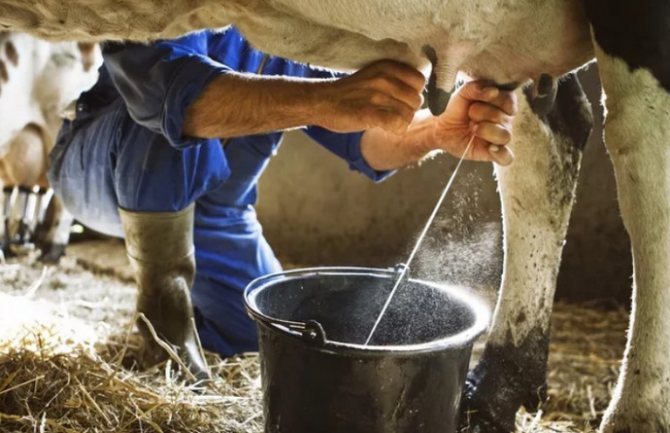
For tethered housing, first you need to prepare the room, for this, clean it of manure and bring some fresh bedding, if necessary. The animal needs to be tied, quite rarely the owners milk the cow when she is just standing there. It is rather difficult to predict the actions of the cow, she may just walk when you are sitting under her. Some representatives even have one hind leg fixed if the cow likes to kick up.
Immediately before milking, you need to tie the tail to the hind leg, the animal will try to drive away insects with it, it can accidentally hit the milker with it. Tied with a special thin rope or with the hair itself at the tip of the tail.
Milkmaid preparation
It does not matter whether the cows are automatically milked with a machine or hands must be thoroughly washed by hand. The hands of the person who is milking should be warm. The area around the udder should be wiped with a dry cloth, and the udder should be washed with warm water, temperature from 40 to 45 ° C. Then wipe the udder dry. In this way, you can not only get rid of the dirt on the milking, but also give a little massage to make the cow milking easier.
Massage before milking
Additionally, you can do a real massage, which lasts no more than a minute. This will not only speed up the milking of the cow, but also allow for good milk yield. The massage consists in stroking the udder, if this is not done, the milk will not be fully milked out, over time its amount will decrease, which sometimes ends with the development of mastitis.
After calving, the udder of the cow needs to be worked out. She needs to be milked. Better to do it with your hands. Not a single machine will crush the udder the way milkmaid hands do it. Massage not only increases milk production and speeds up milk production. It is a good prevention against mastitis. Swelling may develop in areas where milk stagnates.
Some Russian and foreign manufacturers indicate in the equipment passport for which animals the device is intended. Some milking machine models are recommended for milking dairy cows with an already developed udder and long teats, others for heifers who have survived the first calving, and the udder has never been milked.
If you put on larger glasses on the heifer, then you need to constantly monitor their movements. When milking, they go up. The upper edge of the glass is equipped with soft pads, but they can also injure the udder, often in contact with the skin.
Experts recommend sampling milk at the same time, so that the animal's body is already prepared in advance for the production and delivery of milk. Milking is carried out in the same room. It is cleaned of dirt, manure is removed. The stall must be clean.
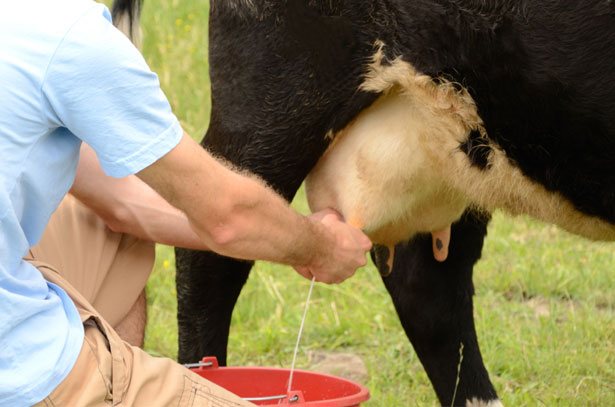

If you bring a cow for milking in a certain room 2 times a day, she will get used to the place. At the appointed hour, she herself will go into her box. Addiction occurs in 5-7 days. Milking is carried out in manual mode as it is comfortable for the animal. Once the habit of housing has developed, the cow must be trained to use the milking machine.For her, noise will be unusual, a different milking mode, the constant presence of teat cups on the teats.
More on the topic:
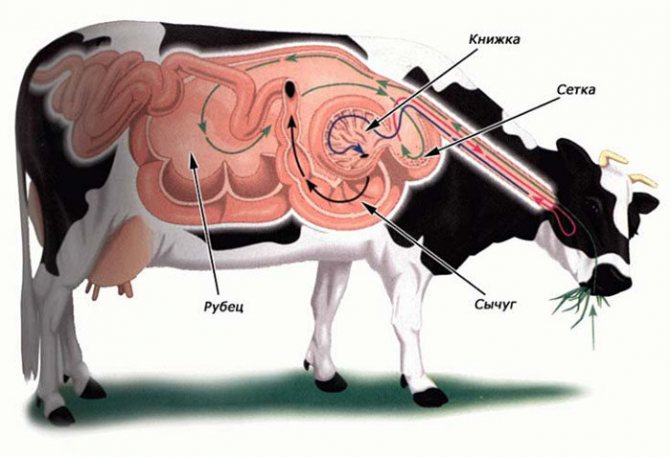

What to do if a cow is swollen?
Bad habits during milking
During milking, sometimes an unpleasant moment happens: the cow begins to kick. This is usually explained by either the bad character of the animal, or painful sensations. Typically, a cow kicks, fights, thrashes and does not milk normally if she feels uncomfortable or afraid.
First heifers can be aggressive during milking if they are not allowed to get used to the process in advance, or if they are taught to milking too quickly and roughly.
What if a cow fights or kicks? In order for the cow not to fight or kick, it is necessary to accurately determine the cause of the behavior problem. If this is a bad temper, the hind leg can be tied to a fence post. If the cause is cracks in the skin of the nipples, it is necessary to treat them with ointment.
- It is difficult and dangerous to milk a cow with your hands when the cow kicks. You can wean you from a bad habit by putting a small whip or whip next to it. The cow should be punished after each kick. Usually one or two times are enough for the animal to stop kicking.
- If the cow is still young, but is trying to kick while milking, then you can try to train her in a more humane way. Before you milk the cow, you need to put some delicacies in the feeder: carrots, pumpkins, fresh grass, apples, and cover the back with a towel dipped in cold water. This will calm the animal.
- Also, the cow will stand more calmly if her legs are entangled. With tangled legs, even a very hard-working cow will stand still and quickly give up her habit. If your legs are constantly confused, you should check the tangling area for scuffs and wounds.
- But when a cow butts, a piece of rubber from a bicycle tire, about a centimeter wide, is put on the ear. You can also wrap the string around your ear. This is quite painful for the animal, but it helps to quickly get rid of the bad habit.
Cow milking techniques
You can milk a cow using the following method:
- Pinch. This method is not recommended for use as it often damages the nipple tissue, but in some cases it cannot be replaced with fist milking.
- Fist. This method allows you to quickly and painlessly milk the milk, and does not affect the condition of the udder.
Pinch method
This method is used when milking animals for which this is the first calving - due to the very short teats, it is impossible to use another method when milking first heifers.
With the plucking method, the nipples are squeezed between the thumb and forefinger (not tightly), and then, with careful movements from top to bottom, the milk is decanted into a bucket. It is important to be careful during milking - the nipple does not need to be pulled down hard, squeezed or jerked.
Fist milking
To prevent milk from leaking during milking, a correct grip of the teat into the fist is necessary. For this:
- the nipple is exactly in the palm of your hand (curvature of the nipple must not be allowed);
- the thumb and forefinger grips the upper part of the nipple, with the thumb slightly higher than the index finger, and the little finger on the outside of the nipple;
- the remaining fingers take turns wrapping around the rest of the nipple.
Once the teat is properly gripped, the milk will not flow back into the udder during milking.
Further stages of milking include:
- gradual, from top to bottom, clenching of the fist, which allows increasing the flow of milk to the nipple (when squeezing, the nipple should not change position, and the stream of milk should contact the hands);
- unclenching of the fist (fingers remain in place, but the grip is weakened).
Important: when squeezing the ring finger and little finger, the fingers above should also be squeezed so that the milk does not flow up the nipple, but flows out in a stream.
Since slow milking reduces the milk yield, up to 80 compressions must be done per minute (at this milking rate, milk is poured into the milk box in a continuous flow).
Even with a milking machine, the farmer needs to know how to properly milk a cow by hand.
To avoid significant friction, apply a little petroleum jelly on the palm of your hand before milking. Place the nipple in the palm of your hand. Its base is clamped with thumb and forefinger. This will prevent milk from flowing back into the udder cavity. You need to squeeze your fingers in turn: middle, ring, and then bend the little finger. During the correct manipulation, milk begins to come out.
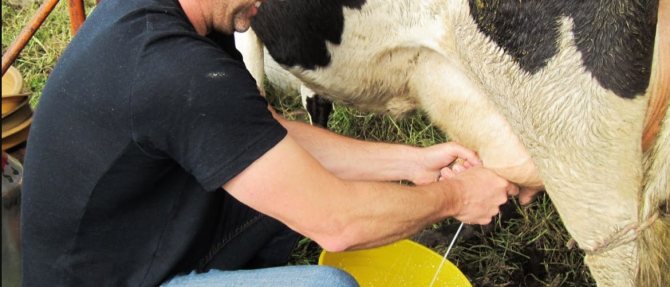

Professional milkmaids do this procedure very quickly. In one minute, they can produce up to hundreds of these clicks, which greatly speeds up the process. You can donate the front nipples in turn, then the rear ones, or you can use only one hand so that the second one has the opportunity to rest during milking.
The bucket, which is installed under the udder, must be secured. The animal can hit it with a foot, stepping during milking, and turn it over. You can fix the bucket with your legs.
Before milking a cow with your hands, you need to make sure that the animal is healthy. For this, a certain amount of milk must be milked in a separate container and carefully examined in good lighting. When mastitis appears, milk has a pink tint, and it can also contain blood clots.
Completion of milking can be recognized empirically by the volume of milk received. You can also stop when your nipples feel empty. At the end of the process, the nipples should be treated with ordinary ghee or a special cream. This will prevent cracking and help prevent dry skin.
There are two main options for milking a cow. In the first case, the animal is milked manually, in the second case it is an automatic process, using special milking equipment.
Hand milking
Some, especially caring owners, turn off the first two jets from each milking into a separate dish covered with gauze. This allows you to reduce the number of bacteria in milk and determine the development of diseases in the early stages. A bucket is used for the entire mass of milk; for the simplest milking, some owners lubricate the milking of a cow with petroleum jelly or pork fat. This can be done at will, dry milking is also acceptable.
But the most important thing is to know how to properly milk a cow with your hands. There are two main ways. The first is fist milking, the second is using only 2 fingers. The latter is used much less often, because milking in this way ends in injury to the udder, which will negatively affect the health of the cow.
You can milk cows by hand or using special machines. If the farm contains only one animal, it makes no sense to buy a special apparatus, but for two or more individuals it becomes a necessity. Milking equipment significantly saves time and effort for the farm owner or staff caring for the herd.
Manual milking method
You need to know how to properly milk the animal so that the milk flows out quickly and evenly, and in the process the udder is completely cleared of milk.
Read more: How to water grapes correctly, how often to water in spring and summer
To learn how to properly milk a cow with your hands, you need to do the following:
- You can correctly grab the nipple as follows: place all fingers on the nipple so that the index finger is under the thumb, and the little finger is from the outside of the nipple;
- Squeezing a fist, it is necessary to ensure that the nipple does not wry, and the pouring milk should not come into contact with the hands;
- In order for milk to pour out of the nipple in a stream, not all fingers are squeezed at once, but from top to bottom: first the thumb and forefinger, gradually going down to the little finger. This technique improves milk flow.
- After that, the fist is unclenched, but the fingers are not removed from the nipple.
- When squeezing of the ring finger and little finger begins, the rest of the fingers should be squeezed so that the milk does not go up. Then the sequence of actions is repeated.
The fingers need to be squeezed frequently so that the milk flows out in a continuous stream (about 80 squeezes per minute). Milking too slow has a negative impact on milk yield. Figure 3 shows a schematic of the technique of hand and machine milking.
Figure 3. Schematic of manual and machine milking
It is best to milk the two front teats first and then the two rear teats, as squeezing milk out first from the right and then from the left lobe may result in insufficient milk evacuation from the back. This is because one part of the udder will be milked with a stronger (right) hand and the other with a weaker one.
What are the mistakes?
At first glance, there is nothing complicated in milking, the main thing is that the cow does not get angry or frightened. But there are little things that can harm milk flow.
Errors in hand milking
Most of the errors are related to the milking regimen and technique:
- Violation of the usual milking regimen - can lead to mastitis, sepsis, death.
- Incomplete emptying of the udder. Leaving milk in the nipples - its quality decreases.
- Entrance to the cow from the left. You need to approach from the right.
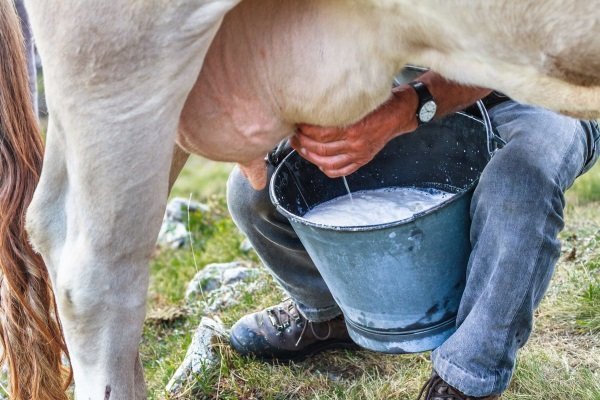

Machine milking errors
If the cow is not prepared for milking, the device will quickly extract the cistern milk, and then work is idle. This happens until the movement of the apparatus causes the reflex again.
"Single milking" causes pain, milk flow is inhibited. Lingering in the udder, it reduces milk yield and harms the condition of the udder - this leads to inflammation and mastitis. During milking, it is impossible to inhibit milk flow by a conditioned reflex way, it is prohibited to:
- rough treatment;
- painful irritation of the nipples;
- change of place and time of milking.
With any type of milking - manual or machine, it is important to comply with hygiene requirements, complete all preparatory measures and follow the milking technique exactly. For large-scale milk production, the milking machine is an irreplaceable thing. If there are one or two cows in the subsidiary farm, you can do with hand milking.
0
Consequences of missed milking
In nature, young artiodactyls feed on mother's milk as needed, therefore, when switching to adult food, lactation decreases and gradually fades away.
Domestic cows produce large quantities of milk on a consistent basis, so skipping milking will result in a very full udder. As a result of excess milk and its pressure on the milk tubules, blood vessels and nerve endings in the udder can:
- severe pain occurs, due to which the animal hums, does not allow itself to be approached and can show aggression;
- develop impaired blood circulation, which causes swelling of the udder;
- cracks appear, as milk spontaneously flowing from the nipples dries up and tightens the skin;
- mastitis develops, since pathogenic microflora can penetrate into the crowded mammary gland;
- the work of the sebaceous glands is disrupted, which is fraught with the development of furunculosis;
- increase in body temperature;
- decrease in productivity.
Changes in behavior and refusal to eat are also present.
Correct udder massage
Udder massage before each milking serves not only to stimulate the production of oxytocin, but also allows you to detect pathological processes that have begun in the mammary gland. The milkmaid strokes the udder with her palms, changing the direction of movement from top to bottom, and then from bottom to top. With her fingers, she probes the nipples and the base of the mammary gland, lifting it. Experience allows her to detect nodules, lumps in the udder, determine if it is hot. The first portion of the released milk is decanted into a separate container, which allows you to detect impurities of pus, curdled clots or blood in it.
Hardware milking
There are several types of milking machines.These machines are classified according to the principle of operation, device mobility and technical characteristics.
Many devices have a similar structure and consist of the following elements:
- tubes: some for air, others for milk transportation;
- teat cups. Four devices in the form of tubes that connect to the nipples;
- pump;
- container for collecting milk;
- piston pump or pulsator, taking into account the type of apparatus;
- collector.
Teat cups consist of a rubber inner tube (suction cup) and a metal tube. A sealed chamber appears between the two elements of the glass.
The principle of operation of the device is quite simple:
- There is a constant pressure in the suction chamber, which is formed by means of a vacuum.
- Compression of the nipple causes the vacuum to pulsate.
- When the same pressure is formed in the suction and interwall chambers, milk begins to come out of the nipple.
According to the classification of milk production, cow milking machines are distinguished: squeezing and suction.
The main criterion when choosing a device is the number of cattle on the farm. For household use, mobile devices are used that allow milking several cows at the same time. This device can be easily moved and very easy to maintain. Having a milking machine on small farms is a great help for farmers.
For large farms, there are devices that allow machine milking of several dozen animals. During the operation of the apparatus, he collects milk from all the cows in one container through special tubes. The milking technology is the same, but this method saves people time and effort.
The ways
In order for the milk productivity of a cow to be high, it is necessary to properly organize its milking and apply the necessary technique. When milking, the mammary gland of the cow is trained, the udder becomes larger in size. The glandular and secretory tissue develops, milk is more intensively formed.
In the course of experiments, scientists have proven that milking allows not only to remove the milk accumulated in the cow, but also has a beneficial effect on the physiology of the udder.
The milking method can be manual or machine. When tethered, the animal must be milked in a stall, using portable buckets or milk pipelines.
By hands
Manual milking takes place in 2 steps. The process begins with the help of "pinching", when the thumb and forefinger gently squeeze the nipples of the cow in order to release streams of milk from them. The process of obtaining milk from a cow is completed by "fist" milking, when all fingers are sequentially squeezed around the nipples, first the index and thumb are squeezed near the base of the nipples, then the middle, ring and little fingers are squeezed alternately. But the hand is held motionless. Each nipple is milked in turn.
Milking machine
During milking, the udder is massaged simultaneously. It is also made separately. At the same time, the blood supply function is improved, nutrients are delivered to the udder of the cow faster, as is the formation of milk between one milking and another. It is also an effective prophylactic agent against cow udder diseases.
Machine milking is simpler than manual milking, which makes the work of milkmaids easier; with the machine method, milk is poured faster and milk will be milked fuller at a time. But more often this method is used on farms and in production, in agricultural yards for the most part manual labor is used, but there is also the use of milking buckets or a milk pipe, which is called a linear method of machine milking. Milking machines are suitable for large areas in an industrial environment.
Machine milking is sucking, not squeezing milk, which is closer to natural conditions for a cow that is sucked by calves after calving.
Before the process of obtaining milk, the udder of a cow is washed and wiped with a soft cloth, lightly massaged.It is necessary to ensure a good fit of the apparatus to the teats of the cow. It is unacceptable to milk or leave milk in the nipples.
After switching on the milking system, you need to wait a little for the pressure build-up. The suction device is put on quickly on each nipple, then the air almost does not get into.
When milking comes to an end, you need to make a slight pulling down of the collector and return it back. Then the milk will be milked to the end. Then the milking device is switched off. The milk is poured into the milk pan. A cow's nipples should be treated with a special ointment or cream. In order for the milking machine to serve for a long time, it should be washed immediately.
The milking method depends on the number of dairy cows and can be hardware or manual.
Hardware milking
In the presence of a herd or even a small number of livestock, manual milking of cows is unproductive, so farmers use machine milking, which increases the milking speed and hygienic milking conditions. On small farms, it is recommended to use mini vacuum units with electronically controlled pulsators, soft barrel and hole edge, and hard liner head.
Read more: Calf gastroenteritis symptoms and treatment, prevention
The devices can be two-stroke (continuous operating mode) and three-stroke (the latter are preferable, since they accurately copy the sucking of the calf due to short pauses). The milking installation is connected according to the instructions.
Before milking, the farmer or milker conducts an udder inspection and massage. In the presence of seals, soreness or fever, this individual is milked last (with severe soreness by hand).
The first streams of milk should be milked into a cup with a black bottom - this allows you to see blood or other impurities in the milk. Then:
- include a milking machine that builds up the required pressure;
- put teat cups on the nipples and check if there is air leakage;
- the optimal milking mode is set for each individual (on average, the pulsation frequency is 45-60 cycles per minute, the process should last no more than 7 minutes);
- after milking, the glasses are carefully removed and the nipples are treated with aids.
At the end of intensive milk flow, the remainder of the milk is expressed manually to prevent mastitis, the apparatus is washed, and the glasses are disinfected (throwing unwashed glasses is prohibited, as they become a breeding ground for infection).
The milk flow rate depends on the vacuum level and the pulsation frequency - the wider the pulsation coefficient, the higher the speed, however, exceeding 65 strokes per minute can have a negative effect on the udder.
Hand milking
After hygienic preparation of the animal, the milker ties the tail to the leg with a loop, since the cow's tail can whip across the face, and dirt can get into the fresh milk. Since people usually have a better right hand than the left, the milkmaid should be located to the right of the cow.
There are general guidelines on how to milk a cow by hand for any technique:
- During milking, first the front teats are removed, and then the rear ones.
- The first trickles are taken into a separate bowl.
- You need to milk at a fast pace in order to empty the udder in 5-7 minutes, since then the milk pressure drops, unnecessary efforts injure the nipples, and not milked milk residues contribute to the development of mastitis and reduce productivity.
Loose and tethered milking
Today in animal husbandry there are two options for keeping cows: loose and tethered. During the tethering of animals, stalls are used, as well as ties (small chains or ropes), which restrict the freedom of the cow, but the length of the tether allows the cow to come to the feeder or lie down.
Milking during strapped housing is more practical: you can take into account the characteristics of the cow, such as character, milk flow rate, udder shape. The barns in which the animals are kept on a leash are usually equipped with milk lines - this reduces physical costs and facilitates the milking process.
On farms where loose cow housing is practiced, special milking parlors are usually built. Animals are divided into groups, selected for similar physiological characteristics, such as age, milk flow rate, milk production. A group of cows for the duration of milking is launched into the hall, in which the attendants only need a couple of minutes to connect the teat cups and start the milking process. After milking is over, the cows leave the hall and the next group starts.
In households, stall keeping of cows is more common. Animals in the stall can be tied, or they can be in it without a tether. With this method of housing, the technology of milking cows resembles a tethered one: manual milking can be used or a milking machine can be used.
Operation of milking machines
This equipment is operated for many hours every day, so it needs service. Devices clean, lubricate and troubleshoot.
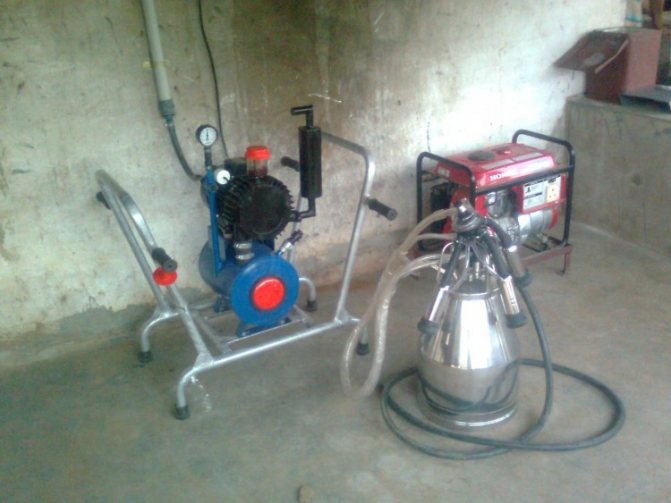

The liner is inspected, as well as the rest of the details of this design.
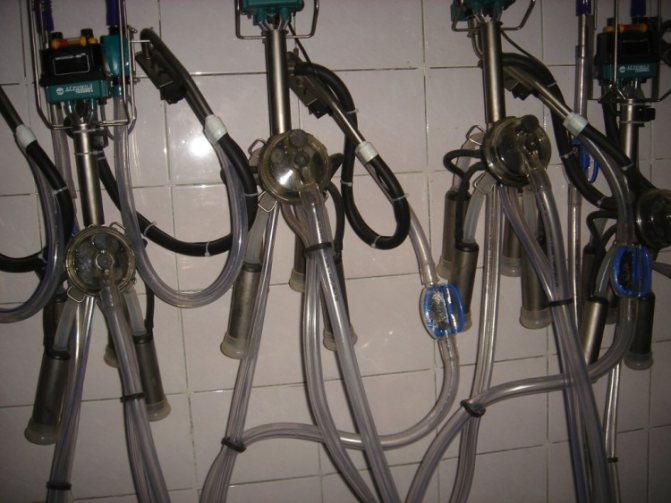

The counters together with the collectors are flushed every day. If you take good care of your equipment, it can last for many years.
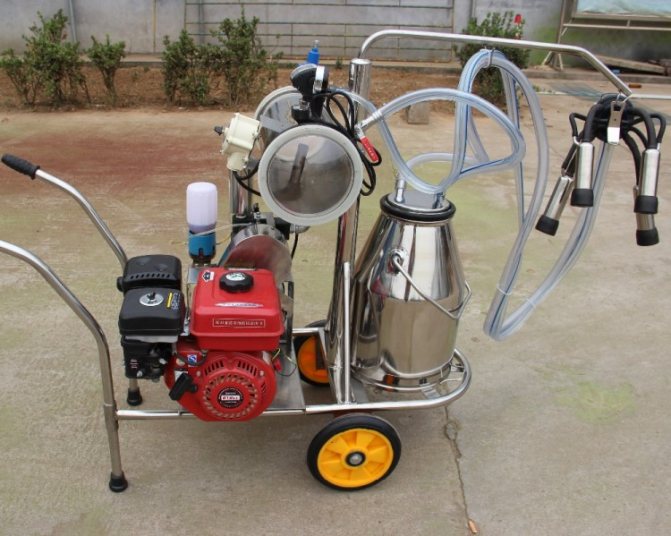

Today any farm is equipped with milking machines. Agricultural modernization is constantly being updated and the milking machine is a must-have for any livestock breeder.
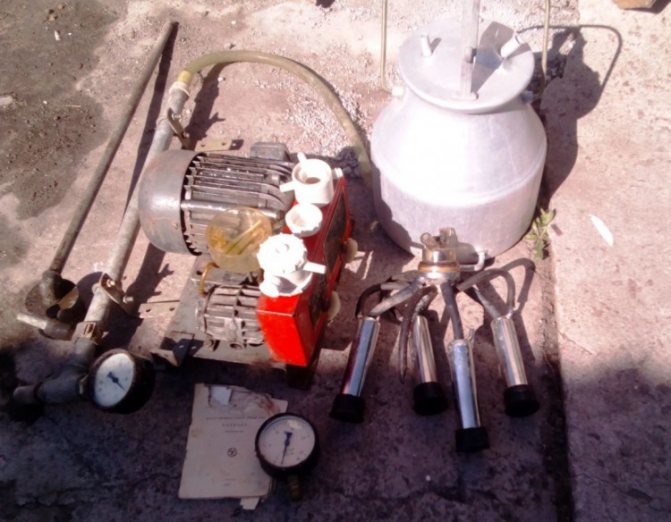

Tips and Secrets
Each cow has its own characteristics of behavior and character, so the farmer needs to look for an individual approach to each cow, however, there are general rules and secrets that help to obtain high milk yield and avoid mastitis and other diseases of the udder of cattle.
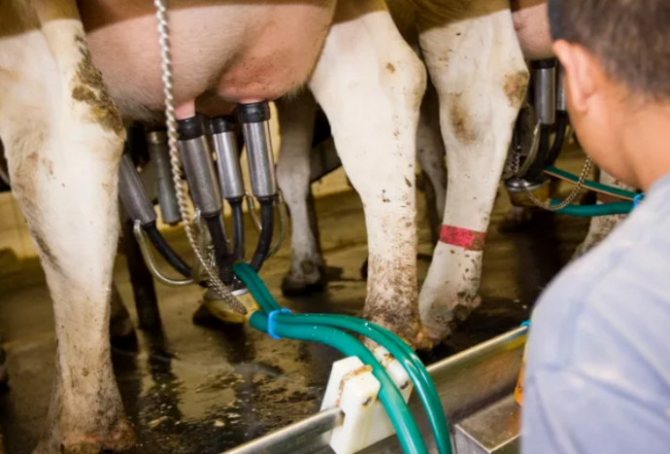

Udder treatment after milk is milked is just as important as pre-treatment - milk residues that remain on the udder are a breeding ground for actively multiplying pathogenic bacteria. In addition, the nutrient fluid can attract insects.
Aids that are used to treat the udder include:
- Cups for milking machines with mesh foam filter for teat treatment with hygiene products.
- Soft textured, massage-like, reusable udder wipes made of non-woven fabric and treated with a special disinfectant.
A ready-to-use hygiene product is a solution containing disinfectant chlorhexidine, polymers, moisturizers and emollients that create a bright gel coat. This membrane, when dried, prevents the penetration of microorganisms into the nipple and teat canal, which reduces the risk of various udder lesions.
Boric petroleum jelly or Zorku cream, which contains floraisin, which accelerates collagen synthesis, is also used to treat the nipples.
When there are no ready-made products available, a mixture of sunflower oil and paraffin is used. To make the mixture, 1/3 of the candle is added to 1 glass of oil and mixed when heated.
After milking, a preventive massage is also done.
It is also important not to let the animal lie down before or immediately after milking - the nipple canal closes completely one hour after expressing milk. Since the cow eats while standing, food and water should be offered to the animal immediately after milking.
The nature of the cows can be different, but not a single cow experiencing irritation will allow herself to be milked - she simply will not let her in or will start kicking.
If there are no problems with the udder, it is recommended to tie the hind legs to the animal using a sliding and not tight knot (you can tie a figure eight), but this method is only suitable in cases where the cow lets the milkmaid close to her and does not kick (it is better to approach the tied animal with front side).
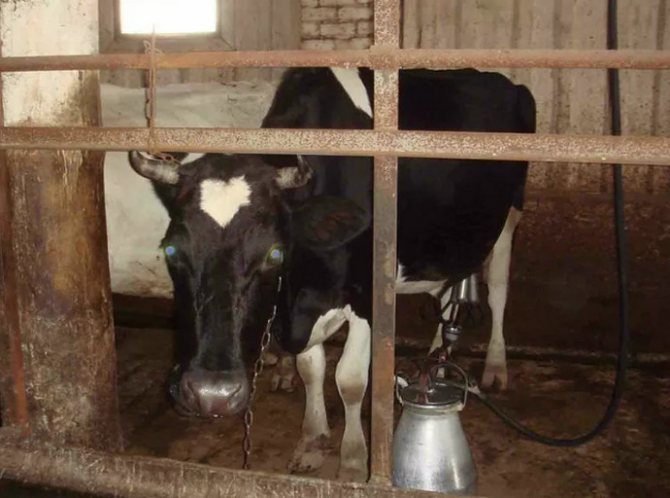

If the cow kicks, a slip loop should be made at the end of the rope. With this loop, they grab the front leg, pull it up and tie it to a secure support. Using this method, it is important to monitor the condition of the rope - if there is no slight tension on the rope, the cow will try to release the leg, which can lead to the animal falling.
Tying for several days can teach an obstinate cow to milking, but experienced farmers advise using another method - the cow should be disposed to you, so you need to try to establish contact with her, appease her and calm her down.
Some animals like a woman to talk to them when milking; some animals cannot stand the presence of strangers, pungent odors, etc. Try to learn the characteristics and preferences of a particular cow, and remember to give the treat.

